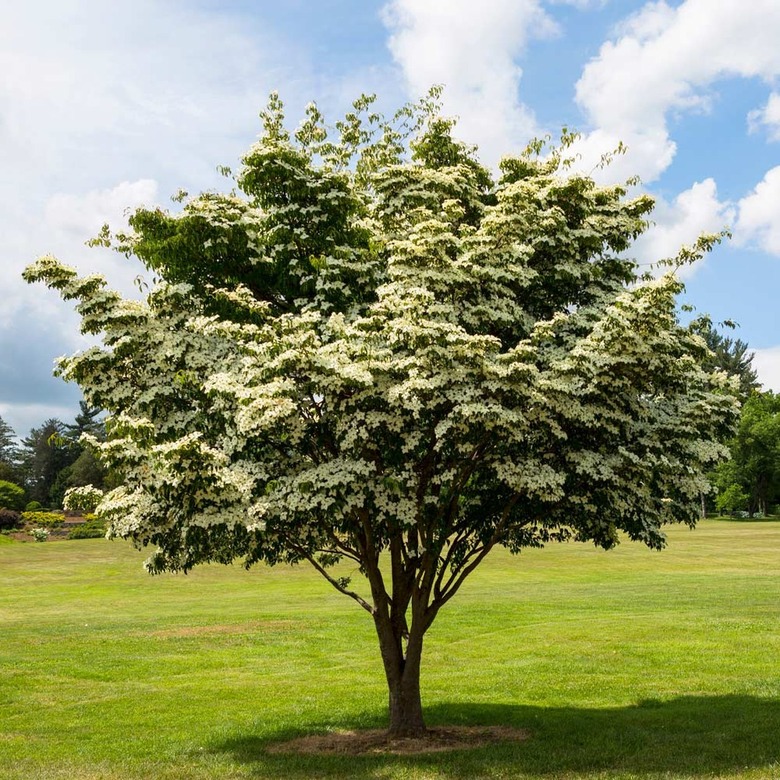How To Prune Kousa Dogwood Trees (Japanese Dogwood)
We may receive a commission on purchases made from links.
Kousa dogwood (Cornus kousa) is a handsome, flowering tree that grows to a medium height in a full-sun location unless it is size-pruned. It is also given the common name Japanese dogwood or Chinese dogwood and is an Asian cousin of the native flowering dogwood Cornus florida. Hardy in USDA plant hardiness zones 5 to 8, the kousa grows slowly but is a shape-changer. As a young tree, its growth aspect is upright and conical, turning to vase-shaped and finally maturing into a dogwood tree with a wide-spreading, rounded canopy.
Pruning is essential if you want your kousa to stay smaller than its mature tree size of 30 feet in both directions. The optimal time for trimming back your dogwood is while it is dormant. Learn when and how to prune kousa dogwood trees to keep them small and shapely all year.
How to Prune Kousa in Winter
How to Prune Kousa in Winter
Since the kousa is deciduous, it loses its leaves in winter, which can make it easier to prune for size. Here's a quick guide on how to prune dogwood:
1. Prepare Pruning Equipment
Bring out the tools you will need for the job. Depending on the size of the branches to be trimmed, you may need a sharp, clean pruner (branches under 1/2 inch in diameter) or a lopper for larger branches (over 1/2 inch but under 1 1/2 inches in diameter) or even a pruning saw (over 1 1/2 inches in diameter). Sanitize the cutting surface by wiping with a clean cloth and denatured alcohol.
2. Evaluate the Branch Structure
Determine which branches need trimming and how much you want to take off. Never take more than one-third of the canopy. You will usually want to take much less.
3. Prune Out Dead and Damaged Branches
Remove dead and damaged branches first in order to better evaluate the branch structure. Dead branches should be cut back to the branch joint. Cut off damaged branches at least a few inches into healthy wood, making the cut at a leaf node. Kousa dogwood is susceptible to damage caused by the larvae of the dogwood club midge, which results in galls (deformed growth) at the ends of branches. Regardless of the time of year, these galls should be pruned out as soon as you see them.
4. Prune Back to Branch Joints
Prune the kousa dogwood branch by branch. Make each cut back to a branch joint rather than using a shearing technique. You don't want to destroy the naturally beautiful form of the tree. Keep in mind the age of the tree — columnar when planted, vase-shaped when young, more spreading when mature — and prune accordingly. Trying to change the shape will likely produce a less attractive specimen and may impact the health of the tree.
5. Use Heading Cuts to Shorten the Dogwood Branches
Use heading cuts to size-prune your kousa dogwood. Make these pruning cuts just above leaf or stem nodes. Keep in mind that buds directly below a heading cut will become new shoots, so select outward-facing buds to encourage shoots to grow outward, not inward.
Need to see the pruning process visually? We recommend watching this video from Knox County Master Gardeners:
How to Prune Kousa After Blooms
How to Prune Kousa After Blooms
The kousa has many appealing features, but the profusion of spring blossoms is the crowning delight — a wealth of white flowers, the dogwood-distinctive white bracts surrounding small greenish-yellow flowers. Since the kousa sets flower buds on old wood, a late-winter/early spring pruning will definitely reduce the number of blossoms in spring. If you are thinking of an annual pruning, this could seriously impact the beauty the kousa dogwood offers.
To get maximum flower power, consider size-pruning just after the tree finishes flowering in June. This will reduce the number of fruits, but the dogwood blooms will be on display in their full glory.
Did You Know?
Kousa dogwood trees possess the same delicate beauty of flowering dogwoods with their starlike spring blooms that appear in late spring about a month after native dogwoods flower. They are slightly more disease-resistant than flowering dogwoods and differ from the native tree in bloom time, fruit structure, and bark texture.
The kousa's lovely dark green leaves are 2 to 4 inches long and are oval. The kousa also offers raspberry-colored berrylike fruits in fall (excellent for jams), botanically called "drupes," that contrast with the brilliant reddish-purple color of autumn foliage. The kousa's peeling bark adds winter interest.
